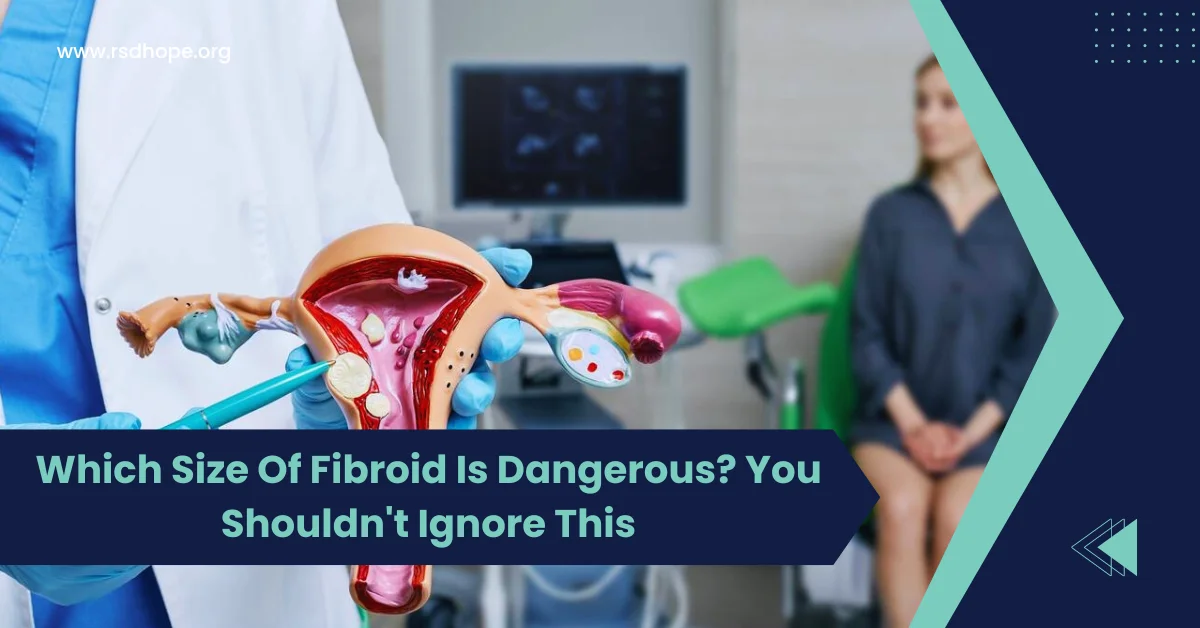Fibroids are non-cancerous growths that develop in the uterus, and they can vary significantly in size. While some fibroids may be as small as a pea, others can grow to the size of a watermelon. Understanding the potential dangers associated with different fibroid sizes is crucial for women’s health and well-being. In this blog post, we’ll explore which size of fibroid is considered dangerous and the risks and complications that can arise.
Key Takeaways
- Fibroids larger than 5 cm in diameter are considered potentially dangerous and may require medical intervention.
- Larger fibroids can lead to severe symptoms and complications, such as heavy bleeding, pelvic pain, and infertility.
- Regular monitoring, early detection, and appropriate treatment can help reduce the risks associated with dangerous fibroid sizes.
Understanding Fibroid Sizes
Fibroids come in various sizes, and healthcare providers typically measure them in centimeters (cm). Small fibroids are usually less than 2 cm in diameter, while medium-sized fibroids range from 2 to 5 cm. Large fibroids exceed 5 cm in diameter and can sometimes grow to the size of a grapefruit or even larger.
Monitoring fibroid size is essential for assessing the potential risks and determining the appropriate course of action. Healthcare providers use medical imaging techniques, such as ultrasound or magnetic resonance imaging (MRI), to measure and track fibroid growth over time.
Also Read: Signs Of Fibroids Breaking Down: Look Out For These Symptoms
Which Size of Fibroid is Dangerous?
While any size fibroid can cause symptoms and discomfort, fibroids larger than 5 cm in diameter are generally considered potentially dangerous. These larger fibroids can lead to more severe symptoms and complications, which can significantly impact a woman’s quality of life.
However, it’s important to note that the severity of symptoms and risks associated with fibroids can vary from person to person. Some women with large fibroids may experience minimal symptoms, while others with smaller fibroids may have severe discomfort. Consulting with a healthcare provider is crucial for determining the individual risk level based on fibroid size and other factors.
Factors That Influence Fibroid Size
Several factors can influence the growth and size of fibroids. Age plays a significant role, as fibroids tend to develop and grow during a woman’s reproductive years and often shrink after menopause. Hormonal changes, particularly high levels of estrogen and progesterone, can stimulate fibroid growth.
Genetics may also contribute to fibroid development and size. Women with a family history of fibroids are more likely to develop them and may experience larger growths. Addressing underlying factors, such as maintaining a healthy weight and managing hormonal imbalances, can help prevent or slow down fibroid growth.
Complications Caused by Different Fibroid Sizes
Fibroids of different sizes can lead to various complications and symptoms. Small fibroids may cause minimal discomfort, but they can still contribute to heavy menstrual bleeding and pelvic pain. Medium-sized fibroids can exacerbate these symptoms and may also lead to frequent urination or constipation due to pressure on the bladder or rectum.
Large fibroids, particularly those over 5 cm, can cause severe complications. They may lead to very heavy menstrual bleeding, anemia, and significant pelvic pain. Larger fibroids can also interfere with fertility by distorting the uterine cavity or blocking the fallopian tubes. In rare cases, fibroids can undergo a potentially life-threatening complication called degeneration, where they outgrow their blood supply and begin to die.
How to Reduce the Danger of Fibroid Sizes?
Reducing the danger associated with fibroid sizes involves a combination of regular monitoring, lifestyle changes, and appropriate treatment. Women should schedule regular check-ups with their healthcare provider to track fibroid growth and discuss any symptoms or concerns.
Lifestyle modifications, such as maintaining a healthy weight, exercising regularly, and managing stress, can help prevent fibroid growth and alleviate symptoms. Medications, such as hormonal birth control or gonadotropin-releasing hormone (GnRH) agonists, may be prescribed to help shrink fibroids and control symptoms.
In some cases, surgical interventions may be necessary to remove dangerous-sized fibroids. Options include myomectomy, which removes the fibroids while preserving the uterus, or hysterectomy, which involves removing the entire uterus. The choice of treatment depends on various factors, including fibroid size, location, and the woman’s individual circumstances and preferences.
Conclusion
Understanding which size of fibroid is dangerous is crucial for women’s health and well-being. Fibroids larger than 5 cm in diameter are considered potentially dangerous and can lead to severe symptoms and complications. Regular monitoring, early detection, and appropriate treatment can significantly reduce the risks associated with dangerous fibroid sizes.
If you have concerns about fibroids or are experiencing symptoms such as heavy bleeding or pelvic pain, don’t hesitate to consult with your healthcare provider. Early intervention and management can greatly improve your quality of life and prevent serious complications down the road.
Read More: Does Progesterone Make You Gain Weight? Uncovering The Truth!
FAQs
A: Fibroids are non-cancerous growths, and it is extremely rare for them to develop into cancer.
A: Yes, fibroids can sometimes shrink naturally, especially after menopause when hormone levels decline.
A: While no specific diet has been proven to shrink fibroids, maintaining a healthy weight and consuming a balanced diet rich in fruits and vegetables may help prevent fibroid growth.
A: The frequency of fibroid monitoring depends on various factors, such as fibroid size, symptoms, and individual risk factors. Your healthcare provider will recommend an appropriate monitoring schedule based on your specific situation.
Sources:
https://www.betterhealth.vic.gov.au/health/conditionsandtreatments/fibroids

